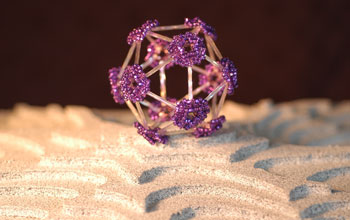Multimedia Gallery
"Purple Haze" Sculpture
"Purple Haze," a sculpture created using 3-D beadweaving, depicts the bacteriophage ÆX174, a virus that infects bacteria. The surface it's resting on portrays an adaptive landscape, a visualization of a concept from population genetics. The ridges represent the gene combinations associated with the fitness of the virus, as measured by how quickly the virus can reproduce. The virus can be said to "climb an adaptive peak" as it evolves to be increasingly fit. The bacteriophage ÆX174 is an important model system for studies of viral evolution because its genome can readily be sequenced as it evolves under defined laboratory conditions.
The design was inspired by a pattern for a Christmas ornament, created by Chris Prussing (Beadwork 2001 Oct/Nov pg. 43). The sculpture was embellished using the Ndebele and peyote stitches. It measures about 3 1/2" inches across and was made using bugle beads, seed beads and Czech crystals. (Date of Image: 2005)
Credit: Sculpture by H. Wichman; surface by A. Johnston, undergraduate student in landscape architecture; photo by J. Palmersheim.
See other images like this on your iPhone or iPad download NSF Science Zone on the Apple App Store.
Images and other media in the National Science Foundation Multimedia Gallery are available for use in print and electronic material by NSF employees, members of the media, university staff, teachers and the general public. All media in the gallery are intended for personal, educational and nonprofit/non-commercial use only.
Images credited to the National Science Foundation, a federal agency, are in the public domain. The images were created by employees of the United States Government as part of their official duties or prepared by contractors as "works for hire" for NSF. You may freely use NSF-credited images and, at your discretion, credit NSF with a "Courtesy: National Science Foundation" notation.
Additional information about general usage can be found in Conditions.
Also Available:
Download the high-resolution JPG version of the image. (1.9 MB)
Use your mouse to right-click (Mac users may need to Ctrl-click) the link above and choose the option that will save the file or target to your computer.

